You’ll find Tucson mixes desert drama, cultural depth, and outdoor adventure in ways that feel effortless; hike among towering saguaros, wander vibrant historic neighborhoods, and cool off on high mountain trails while museums and mission architecture add fascinating layers. This list points you to the top spots—from botanical gardens to scenic drives and sunset viewpoints—so you can pick what fits your pace and start planning a trip that’s equal parts exploration and relaxation.
Hike Saguaro National Park East and West
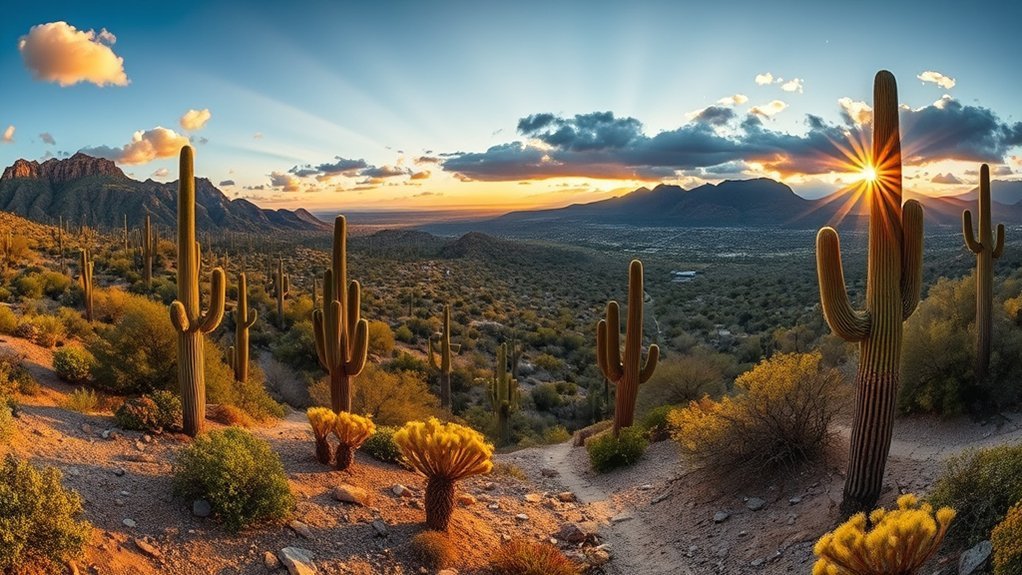
Rising before the desert heat, you’ll find Saguaro National Park‘s East and West districts offering two distinct ways to experience the iconic saguaro forests: Tucson Mountain Park‘s western slopes serve up wide, sunset-painted vistas and short loop trails ideal for casual hikers, while the Rincon Mountain foothills on the east provide higher-elevation hikes, cooler microclimates, and longer routes that dive deep into dense cactus stands. You’ll choose routes by skill and mood: try the gentle Valley View or Desert Discovery loops for interpretive panels and accessible viewpoints, or head east for the Signal Hill area and longer stretches like the Hugh Norris Trail if you want solitude and varied terrain. Bring sun protection, plenty of water, and sturdy shoes; temperatures shift fast and shade is sparse. Keep an eye out for nesting birds, javelina tracks, and the sculptural silhouettes of saguaros at dawn and dusk. Park rangers offer maps and seasonal tips, so stop by for current trail conditions before you go.
Explore the Arizona-Sonora Desert Museum
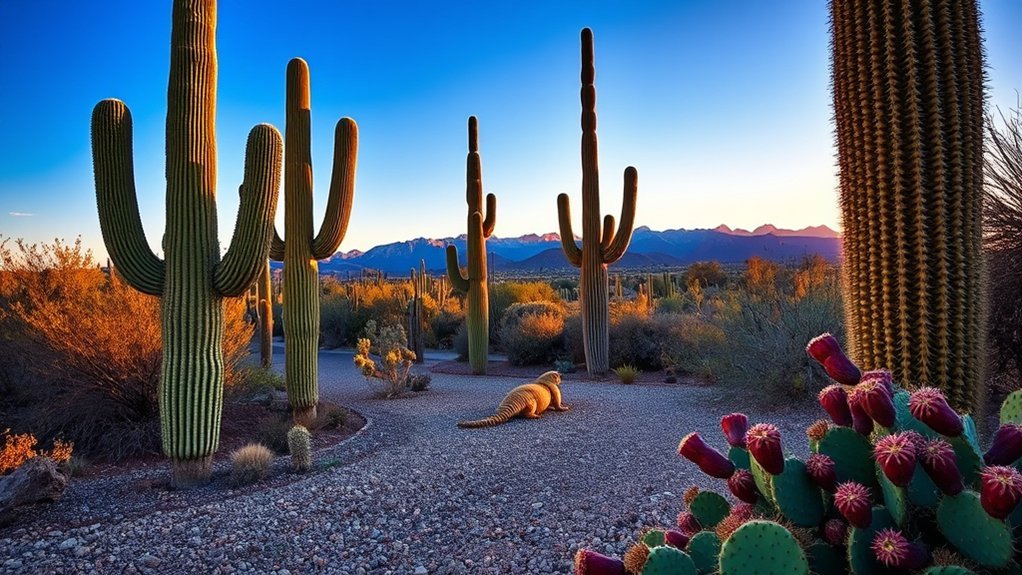
Step into the Arizona-Sonora Desert Museum and you’ll see live desert animals—raptors, bobcats, and desert tortoises—thriving in naturalistic habitats. You can also wander botanical trails showcasing cacti and native plants alongside interactive geology displays that explain the region’s volcanic and sedimentary history. It’s a compact, hands-on way to connect with the Sonoran Desert’s wildlife, plants, and rocks.
Live Desert Animal Exhibits
Wander through the Arizona-Sonora Desert Museum and you’ll come face-to-face with the region’s wildlife in naturalistic enclosures that foreground behavior and habitat. You’ll watch raptors wheel overhead in flight demonstrations, hear staff explain hawk and owl adaptations, and see javelina rooting through shade-scrub exhibits. Trail-side viewing lets you observe a mountain lion’s pacing, a coati’s curious foraging, and a kit fox slipping between rocks—each species presented with interpretive signage that explains diet, range, and conservation status. Keep an eye out for interactive talks where keepers answer questions and demonstrate enrichment techniques used to stimulate animals. Photography is allowed from designated spots, but you’ll want to move quietly and respect barriers to avoid stressing the animals.
Botanical and Geology Displays
After watching animals go about their lives, shift your attention to the plants and rocks that shape those habitats—the museum’s botanical and geology displays show how desert life fits together. You’ll wander paved trails through curated creosote flats, cactus gardens, and thorn-scrub, noting microhabitats where pollinators, reptiles, and mammals intersect. Interpretive signs explain water strategies, seed dispersal, and seasonal rhythms; you’ll learn why saguaros lean, how nurse plants shelter seedlings, and which soils favor brittleleaf versus palo verde. Rock exhibits reveal the region’s tectonic history, mineralogy, and the role of erosion in sculpting washes and bajadas. Hands-on stations and seasonal plantings make complex processes tangible, so you leave with a clearer sense of the Sonoran Desert’s resilience and geological story.
Stroll Through Tucson Botanical Gardens
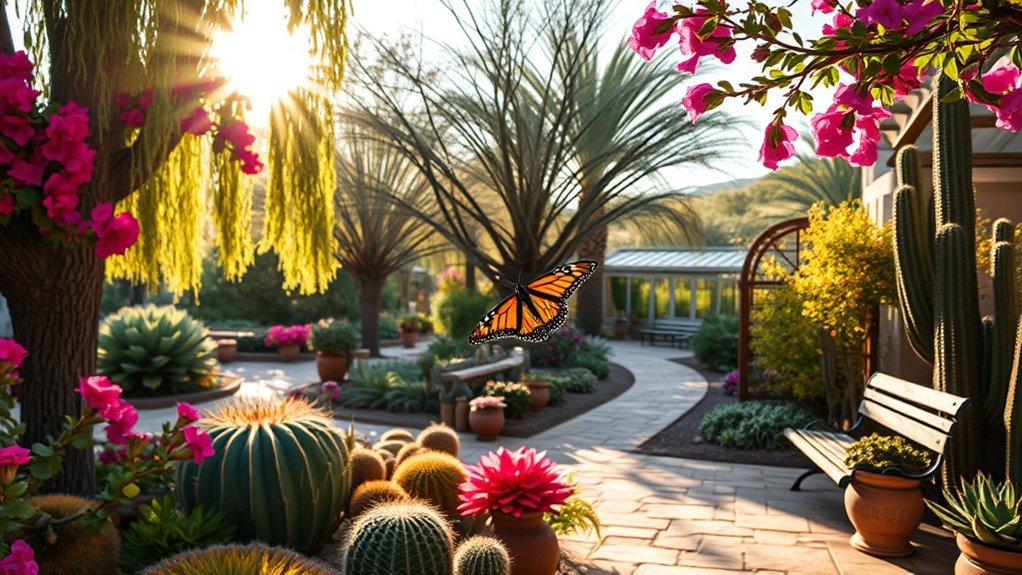
You’ll wander through rotating seasonal plant displays that burst with color and scent, from spring wildflowers to autumn cacti blooms. The Gardens sit on the historic Romero Ranch, where shaded patios, a restored adobe homestead, and shady pathways tell Tucson’s gardening story. Take your time—there are quiet nooks, interpretive signs, and photo-worthy views around every corner.
Seasonal Plant Displays
When the seasons shift, the Tucson Botanical Gardens rearranges its palettes to showcase blooms and foliage that thrive in the desert climate, so you’ll see dramatic contrasts from month to month. You’ll wander through themed beds where spring brings profusions of native wildflowers and citrus blossoms, while summer highlights heat-tolerant succulents and blooming agaves. In fall, crisp light intensifies warm tones of sages and autumnal cacti blooms; winter offers surprising color from Mediterranean and desert-adapted shrubs. Interpretive signs explain plant adaptations and seasonal care, so you’ll learn why certain species flower at specific times. Guided tours and rotating displays help you plan visits for peak color. Bring a camera, water, and comfortable shoes—seasonal shifts reward repeat visits.
Historic Romero Ranch
Step back into Tucson’s past as you stroll the Historic Romero Ranch within the Botanical Gardens, where shaded patios, original adobe walls, and a 19th-century citrus grove recall life on a working Sonoran ranch. You’ll wander pathways framed by native trees and heirloom fruit trees, imagining daily rhythms of watering, harvesting, and family gatherings. Interpretive signs explain irrigation methods, historic plant varieties, and restoration efforts that preserved the ranch’s character. You can peek into restored rooms that display period tools and photographs, giving you tangible links to early Tucson homesteading. The ranch’s intimate scale invites slow exploration; pause on a bench beneath citrus branches, breathe the orange-scented air, and feel how history and horticulture merge in this peaceful pocket of the city.
Visit Mission San Xavier Del Bac
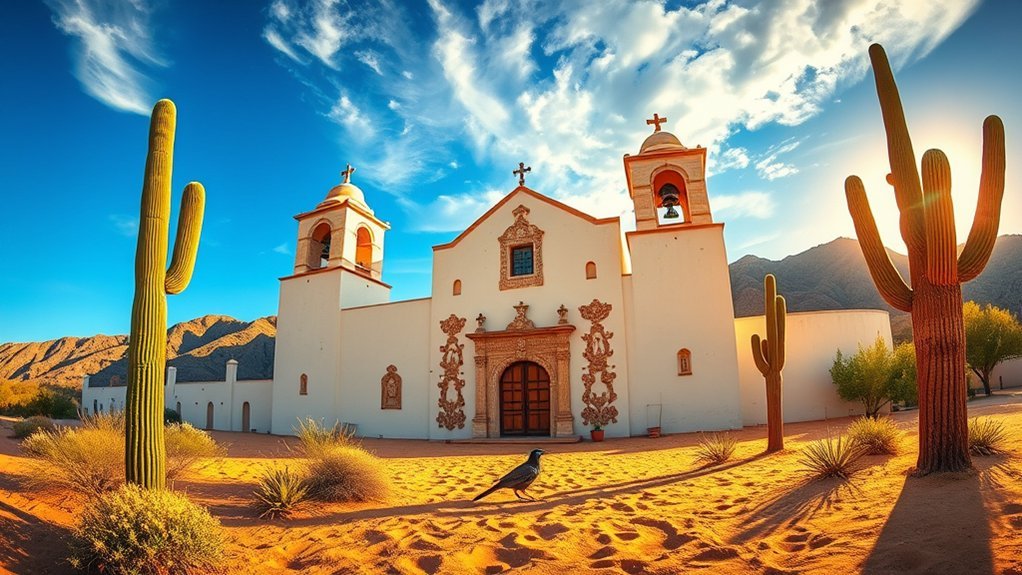
Tucked just south of Tucson, Mission San Xavier del Bac welcomes you with its gleaming white stucco walls and intricately painted interior—an enduring example of Spanish Colonial architecture and Tohono Oʼodham history. You’ll step into a hushed, luminous nave where carved saints and vivid frescoes draw your eye; guided tours explain restoration efforts and the mission’s role as a living parish. Walk the grounds to see the bell tower, desert gardens, and interpretive panels that connect mission life to indigenous traditions. Respectful photography is allowed; services are open to visitors, offering a glimpse of community rituals.
| What to See | Why It Matters |
|---|---|
| Frescoes & altarpieces | Blend of European and indigenous artistry |
| Bell tower | Iconic landmark for photos |
| Parish services | Observe living traditions |
| Restoration exhibits | Learn conservation efforts |
| Desert gardens | Native plants and quiet reflection |
Plan for shade, bring water, and give yourself time to absorb the serene atmosphere.
Wander Barrio Viejo Historic District
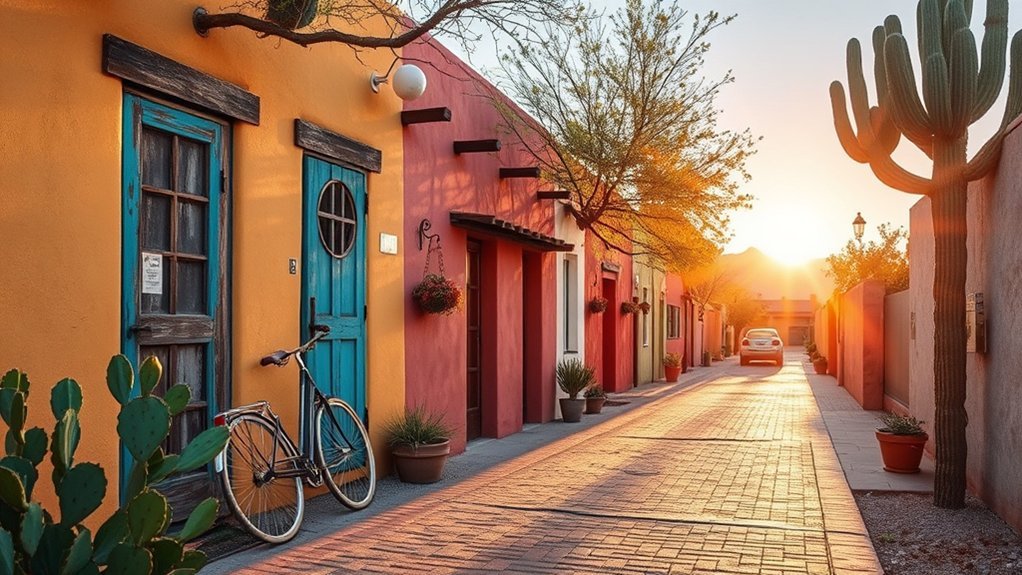
Stroll through Barrio Viejo and you’ll find rows of historic adobe homes that whisper Tucson’s past through thick walls and carved wooden doors. Keep your eyes open for vibrant street murals that burst with color and local stories around every corner. You’ll want a camera — and time to wander slowly to soak it all in.
Historic Adobe Homes
When you wander into Barrio Viejo, you’ll immediately notice rows of historic adobe homes with thick earthen walls, wooden vigas, and weathered plaster that tell stories of Tucson’s 19th-century roots. You’ll want to slow down and take in sculpted doorways, tiny courtyards, and wrought-iron details that reveal craftsmanship tied to Sonoran traditions. These houses show how materials and climate shaped daily life.
- Learn: Read plaques and small signs that explain construction techniques like sun-dried adobe bricks and lime plaster.
- Observe: Note roof profiles, recessed windows, and original wooden beams that survived generations.
- Photograph respectfully: Capture texture and scale, but respect residents’ privacy and private yards.
The neighborhood rewards careful, unhurried exploration.
Colorful Street Murals
Turn a corner and you’ll find Barrio Viejo bursting with colorful street murals that mix Sonoran history, local politics, and playful pop culture in bold, layered strokes. You’ll wander narrow streets as murals unfold stories: mission-era figures, desert flora and fauna, and portraits honoring community organizers. Each wall uses texture, stencil, and brushwork to guide your eye; vibrant palettes contrast weathered adobe for striking photos. Look for artist signatures and plaques that explain context and intent, and you’ll learn about neighborhood preservation and contemporary issues shaping Tucson. Time your visit for daylight to catch true colors, and wear comfortable shoes—murals spread across blocks. Respect private property, stay on sidewalks, and let the art invite conversation and exploration.
Drive Mount Lemmon Scenic Byway
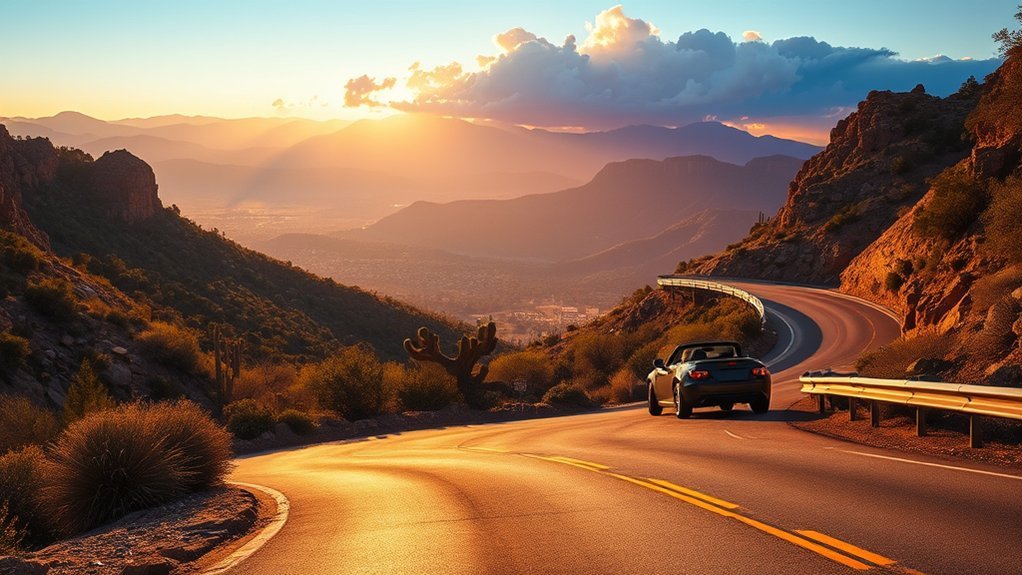
Winding up from Tucson, the Mount Lemmon Scenic Byway climbs through desert, oak, and pine ecosystems, giving you dramatic vistas, switchbacks that reveal the city shrinking below, and pullouts perfect for photos or a quick picnic. You’ll find the road itself is part of the attraction: narrow lanes, hairpins, and changing light create a sense of ascent that’s both peaceful and exhilarating. Stop at viewpoints to scan saguaros below, watch clouds gather over the Santa Catalinas, or listen to wind in the pines. Pack layers—temperatures shift fast—and bring a camera, water, and sturdy shoes if you plan a short hike from a trailhead. Expect wildlife sightings like javelina or birds of prey.
- Mount Lemmon Overlook: sunrise and sunset panoramas.
- Summerhaven Village: cafes, bakeries, and a small alpine feel.
- Trailheads: quick walks to cool groves and scenic ridgelines.
Discover Exhibits at the Tucson Museum of Art
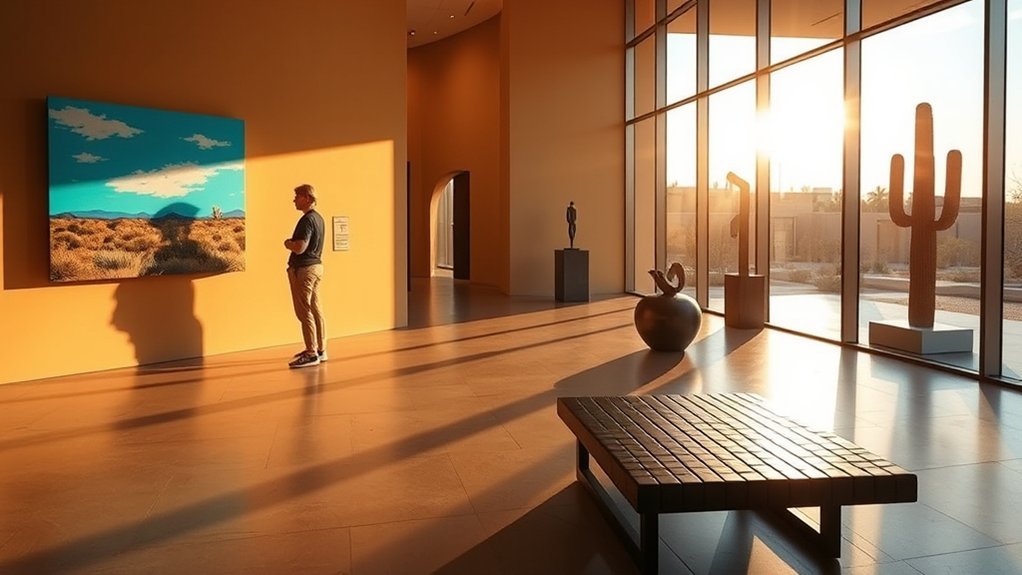
Although it may sit quietly on a downtown block, the Tucson Museum of Art invites you to wander through centuries of Southwestern and global creativity, from Indigenous pottery and Spanish colonial canvases to contemporary installations and photography. You’ll find thoughtfully arranged galleries that highlight regional narratives—pre-Columbian ceramics, Native American textiles, and mission-era works—paired with rotating exhibitions that bring fresh perspectives. Interactive labels and audio guides help you connect context to craft, so you’ll understand techniques, materials, and stories behind each piece. Don’t miss the sculpture garden and rooftop terrace, where desert light changes the mood of installations as the sun moves. Temporary shows often showcase local artists, giving you a snapshot of Tucson’s vibrant creative community. The museum’s shop stocks artful books and artisan goods, perfect for a keepsake. Plan at least an hour to soak in key galleries; longer if a special exhibit is on view, and check the calendar for lectures or curator tours that deepen your visit.
Tour the Pima Air & Space Museum
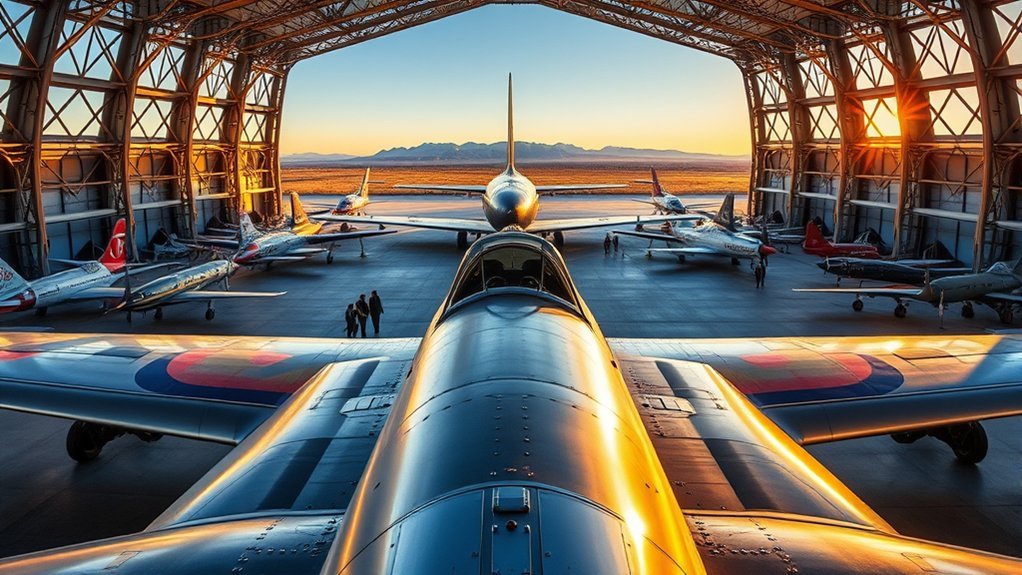
Step into aviation history at the Pima Air & Space Museum, where you’ll wander among more than 350 aircraft spread across sprawling outdoor and hangar spaces—everything from World War II bombers and Cold War fighters to experimental planes and commercial airliners. You’ll trace design evolution up close, read pilot stories, and feel the scale of a B-52 or the sleek lines of a supersonic jet. Interactive exhibits and knowledgeable docents bring technical details to life, whether you’re curious about engines, avionics, or restoration techniques.
- Take a guided tour to access behind-the-scenes restoration areas and hear expert anecdotes about notable airframes.
- Visit the exhibit halls for themed collections—military aviation, space-related artifacts, and rare prototypes with placards that explain context.
- Stop by the gift shop and cafe to pick up aviation books, scale models, and a coffee before you continue exploring the tarmac and hangars.
Catch a Sunset at Gates Pass
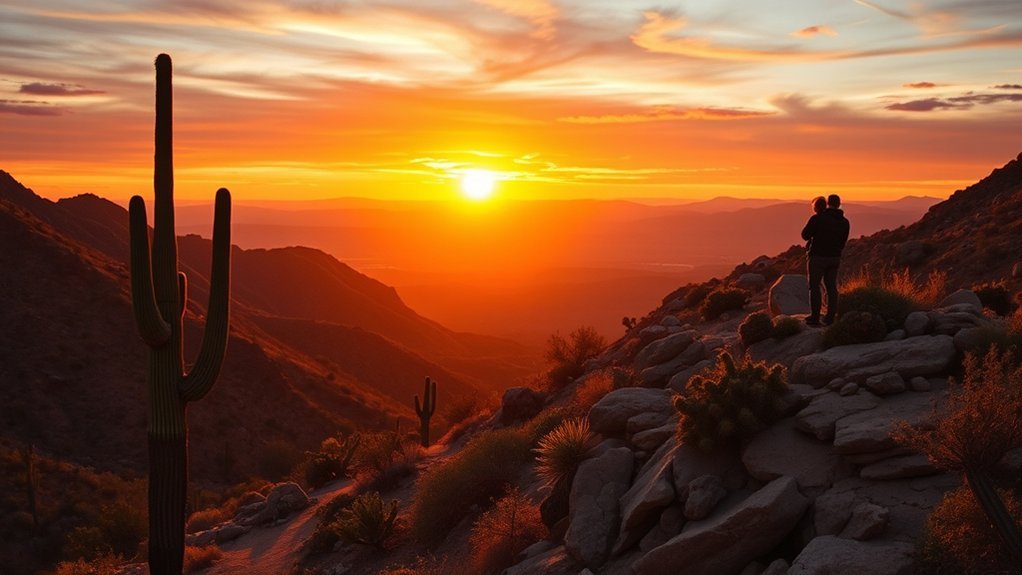
Head to Gates Pass for panoramic overlooks where you can pick a spot on the western rim or along the paved pullouts for unobstructed views. Check sunset times and arrive 30–45 minutes early to catch the changing light and cooler temperatures as the sun sinks behind the Tucson Mountains. Bring a light jacket and a camera — the colors shift fast, so positioning and timing make all the difference.
Best Viewing Spots
When the sun dips behind the Tucson Mountains, Gates Pass gives you a front-row seat to a sky that blazes from gold to magenta; pull into the turnout, step onto the rocky ridge, and you’ll feel the valley shift colors beneath you. You’ll want to explore a few vantage points so each visit feels fresh and deliberate.
- Upper turnout: Park close to the overlook for an unobstructed panoramic view of Saguaro-studded ridgelines and the city below.
- Lower pullout near the switchbacks: Hike a short distance to find quieter ledges with layered silhouettes and intimate framing of distant peaks.
- Small side trail: Climb a rocky knoll for elevated perspectives that accentuate depth and foreground cacti shapes.
Sunset Timing Tips
After you’ve picked your favorite vantage at Gates Pass, timing makes the difference between a pretty sunset and an unforgettable one. Aim to arrive at least 30–45 minutes before official sunset to watch the light shift across the Tucson Mountains; early arrival gives you time to settle, scout compositions, and catch golden-hour tones. Check local sunset times and subtract a buffer for traffic and parking—weekends fill fast. If you want longer color, stay 15–30 minutes after sunset for post-sunset alpenglow and richer purples. Bring a jacket; desert temperatures drop quickly. Use your phone’s live-photo or interval setting for time-lapse shots, and consider a small tripod for stability. Watch the western horizon for clouds; thin high clouds amplify color, low clouds can block it.
Experience the Sonoran Food Scene on Fourth Avenue
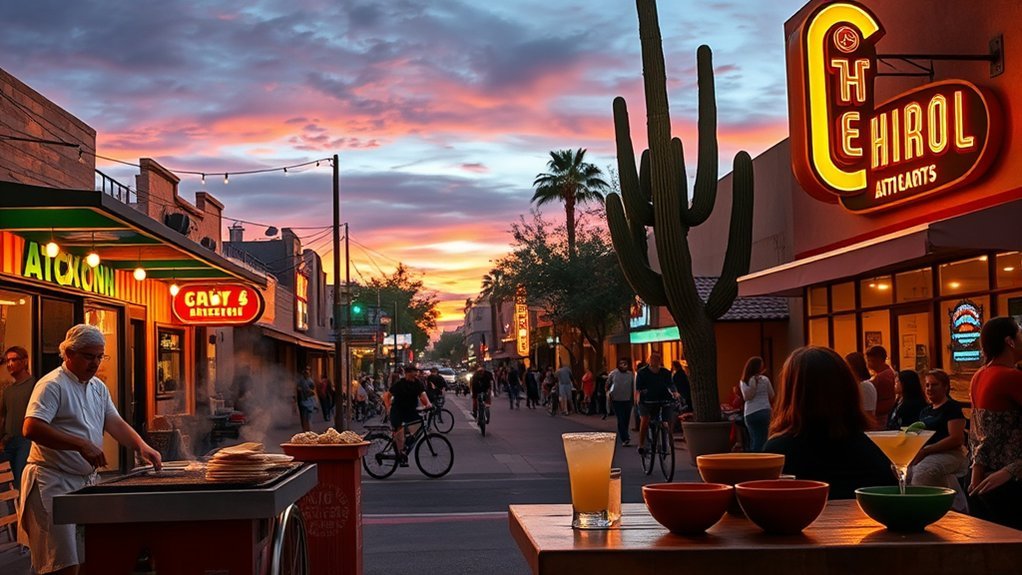
Wander down Fourth Avenue and you’ll dive straight into Tucson’s vibrant Sonoran food scene, where family-run taquerias, inventive chefs, and seasonal markets serve dishes rooted in local tradition and cross-border flair. You’ll smell grilled carne asada, fresh tortillas, and roasting chiles as you explore patios and storefronts buzzing with conversation. Follow these highlights to taste the neighborhood’s character.
- Try a classic Sonoran hot dog topped with pinto beans, salsa, and grilled onions at a street cart for an authentic, handheld flavor lesson.
- Visit a small taqueria or chef-driven spot for slow-cooked birria, citrusy ceviche, or nopales salads that showcase local ingredients and Mexican-Arizona fusion.
- Stop by a farmers’ market or specialty shop to pick up prickly pear jam, mesquite honey, or heirloom chiles—perfect souvenirs and a way to cook Tucson at home.
You’ll leave with bold flavors, friendly service, and a better sense of how food shapes Tucson’s cultural landscape.
Attend a Performance at the Rialto Theatre
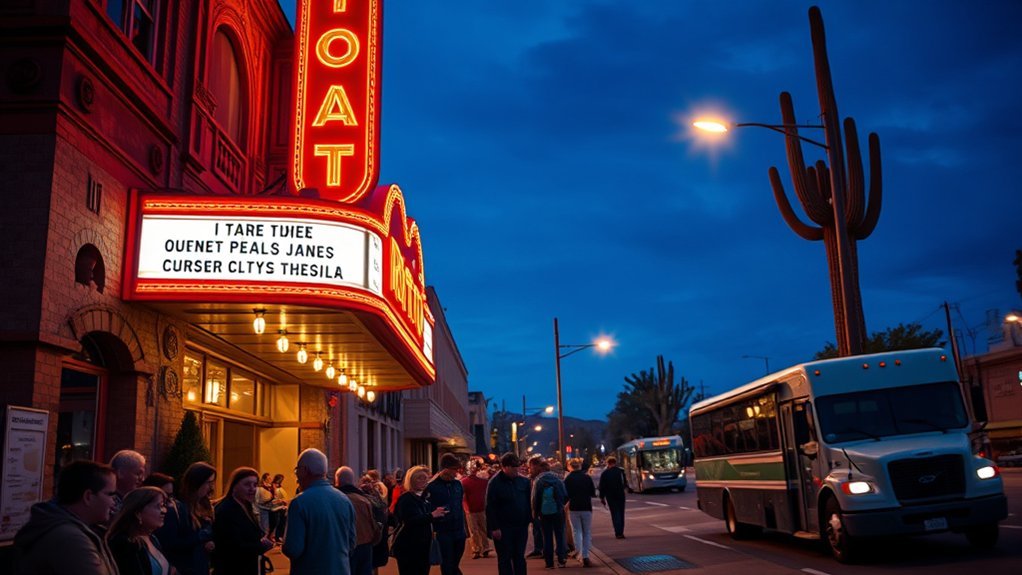
Step into the Rialto Theatre and feel the historic charm of its restored marquee and ornate interior as you take your seat. You’ll catch everything from indie bands and jazz ensembles to touring comedians and film screenings, so check the event calendar to pick a night that matches your mood. Buy tickets early and sign up for the venue’s newsletter to snag announcements, presales, and last-minute updates.
Historic Venue Charm
When you enter the Rialto Theatre, you’re met with a gilded, old-Hollywood glow that makes even a casual concert feel like an occasion; the ornate marquee, velvet seats, and atmospheric lighting transport you back to 1920s Tucson while sound and sight stay thoroughly modern. You’ll notice plaster moldings, vintage chandeliers, and period details preserved with careful restoration, giving the evening a tangible sense of history. The venue’s intimacy keeps you close to the stage, so every expression and nuance registers.
- Architectural details: admire murals, proscenium arch, and original fixtures.
- Comfortable viewing: tiered seating and clear sightlines make shows immersive.
- Heritage context: on-site photos and staff anecdotes connect you to the Rialto’s past.
Live Music Variety
After soaking in the Rialto’s vintage glamour, you’ll find the lineup itself just as entrancing — a rotating mix of indie rock, jazz, Americana, and touring tribute acts keeps the calendar lively. You’ll hear crisp acoustics that suit intimate singer-songwriters and full-band rock alike, thanks to the theater’s thoughtful sound setup. Expect dynamic nights: soulful vocals one evening, brass-driven swing the next, and foot-stomping alt-country when a regional favorite rolls through. The venue’s size keeps performances immediate — you’re close enough to catch subtle expressions and band interplay. Local promoters often pair national headliners with emerging Arizona talent, so you’ll leave having discovered someone new. Bring cash for merch and arrive early to soak the ambiance.
Event Calendar Tips
Because shows at the Rialto move quickly and sell out, check the theater’s calendar early and sign up for email alerts so you’ll know about ticket drops and presales before they vanish. You’ll want to scan weekly listings, follow the Rialto on social media, and set calendar reminders for on-sale dates. That way you won’t miss a favorite act or a rare acoustic night.
- Monitor the calendar — filter by genre and date to find performances that fit your mood.
- Use presale codes and venue alerts — they often release limited blocks before general sale.
- Arrive early and grab good seats — lobby doors, merch stands, and local food trucks make arrival part of the experience.
Bike the Loop River Park Trails
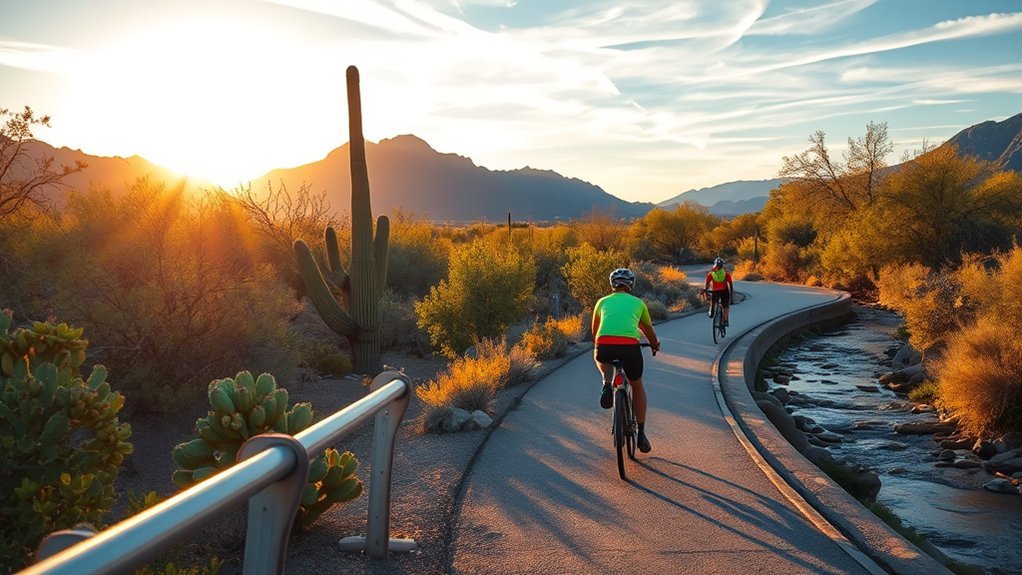
Hop on your bike and cruise the Loop River Park Trails to see Tucson from a fresh, fast-moving perspective. You’ll follow paved corridors that thread through riparian habitat, mesquite bosques, and desert washes, spotting birds and seasonal wildflowers as you go. The Loop links parks, neighborhoods, and cafés, so you can plan a relaxed loop or push a longer ride. Signage and mile markers make navigation easy; maps and water refill stations are available at key trailheads. Trails are mostly flat and family-friendly, but watch for occasional gravel approaches and shared-use etiquette—slow for pedestrians and announce passes. Mornings and evenings offer cooler air and golden light; weekends can be busier. Rent a hybrid or e-bike if you want extra range without sweat. Bring sunscreen, a helmet, and a lock for pit stops. Whether you want a short nature escape or a cardio workout, the Loop delivers accessible scenery and a true Tucson cycling experience.
Explore Old Tucson Studios
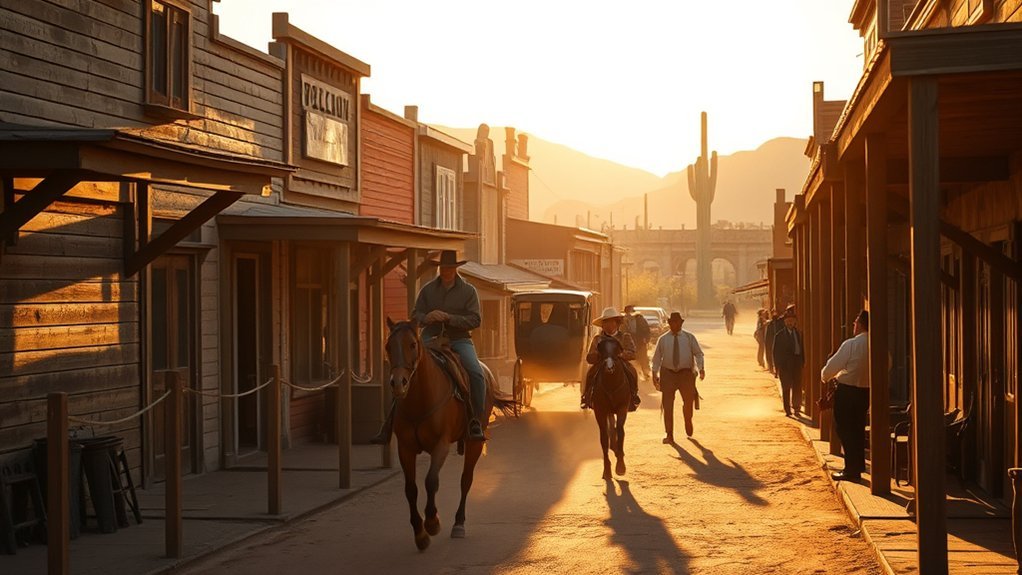
Step onto the dusty streets of Old Tucson Studios and you’ll recognize classic Western movie sets that transported stars and crews for decades. You’ll catch live stunt shows that thrill with gunfights, horse chases, and pyrotechnics timed to perfection. With hands-on exhibits and family-friendly attractions, it’s a day trip that entertains visitors of all ages.
Classic Western Movie Sets
Dust-swept streets and saloon doors creak back to life at Old Tucson Studios, where you can walk through movie sets that starred in classic Westerns and feel the echo of camera shutters and horse hooves. You’ll explore authentic facades, props, and period details that filmmakers used to craft dusty frontier tales. Audio guides and plaques point out famous films and moments, so you’ll spot where scenes were shot and why the backdrops still read as cinematic gold. As you move between storefronts and a weathered courthouse, imagine costume crews and directors shaping each take. Don’t miss these signature set pieces:
- Main Street facades with working storefronts and signage.
- The original town square and courthouse exterior.
- Restored saloon interiors with period furnishings.
Live Stunt Shows
Feel the roar of pistols and the thunder of hooves as Old Tucson’s live stunt shows throw you into the middle of a high-energy Western spectacle; skilled stunt performers race, tumble, and stage daring fights and falls that replay classic frontier drama before your eyes. You’ll watch choreographed gunfights, horseback chases, and precision falls that blend safety with showmanship. The pacing keeps you breathless, the set pieces look authentic, and performers interact with the audience so you feel part of the action. Timing, sound effects, and practical pyrotechnics amplify every moment. Plan to arrive early for a good seat and check the daily schedule for special matinees or evening performances — each run offers slightly different stunts and surprises.
| Feature | Why it thrills |
|---|---|
| Horseback chases | Speed, skill, authenticity |
| Gunfight choreography | Tension, timing |
| Fall stunts | Adrenaline, precision |
| Pyrotechnics | Visual impact, realism |
Family-Friendly Attractions
Often you’ll find Old Tucson Studios turning into a hands-on playground for families, where kids and adults can explore movie sets, meet costumed characters, and try simple, safe activities that bring the Old West to life. You’ll stroll dusty streets recreated for film, peek into saloons and storefronts, and feel like an extra in a vintage western while guides share fun facts. Interactive demonstrations—blacksmithing, stagecoach rides, and stunt rehearsals—are scaled for younger visitors, so everyone can participate.
- Take a guided set tour to learn filming history and spot famous scenes.
- Ride a family-friendly stagecoach for a short, scenic loop.
- Join a supervised hands-on demo—panning for “gold” or trying basic cowboy crafts.
Taste Local Flavors at the Fourth Avenue Street Fair

Stroll down Fourth Avenue and you’ll be met with a riot of smells and flavors—smoky grills, sweet churros, and the bright citrus of fresh-squeezed aguas frescas—where local cooks and food trucks serve up Tucson’s Sonoran-rooted cuisine. You can sample carne asada tacos, Sonoran hot dogs topped with pinto beans and jalapeños, and inventive fusion dishes that blend Mexican, Native, and Southwestern traditions. Look for booths offering blue corn tortillas, prickly pear syrups, and locally roasted coffee. Vendors often list ingredients and spice levels, so you can ask about heat or vegetarian options. Bring cash for smaller stands, though many accept cards and mobile pay. Grab a bench, people-watch, and savor handmade sauces and freshly grilled meats. If you’re curious, chat with chefs—they love explaining regional techniques like grilling over mesquite or using dried chiles. By the time you leave, you’ll have a clear sense of Tucson’s culinary identity and where to return for a full meal.
Walk the University of Arizona Campus and Museums
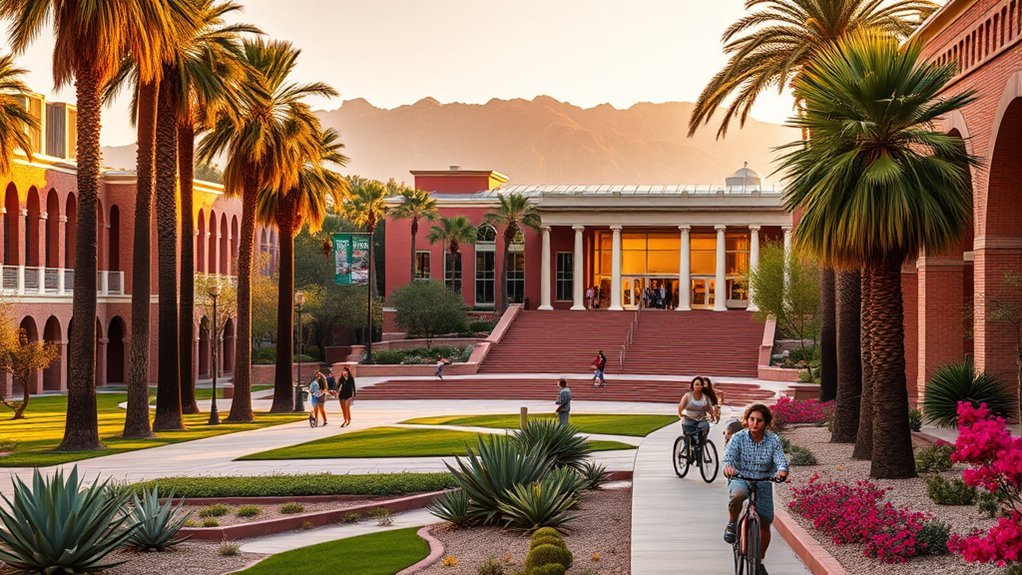
Wander through the University of Arizona campus and you’ll find a compact blend of history, art, and science that’s easy to explore on foot. You’ll stroll under shady palms and citrus trees, pass redbrick buildings with Spanish Colonial details, and feel the energy of a lively college town. The campus museums are highlights — they’re thoughtfully curated and close together, so you can sample art, archaeology, and natural history without backtracking.
- Flandrau Science Center & Planetarium — Catch a planetarium show or interactive exhibit to get a hands-on feel for astronomy and regional geology.
- Center for Creative Photography — See powerful photography collections, including work by Ansel Adams; rotating exhibits keep visits fresh.
- Arizona State Museum — Explore Indigenous artifacts, pottery, and cultural history that illuminate the Southwest’s human story.
Wear comfortable shoes, check museum hours online, and leave time to enjoy a coffee or lunch at a campus café between stops.
Visit the Mini Time Machine Museum of Miniatures
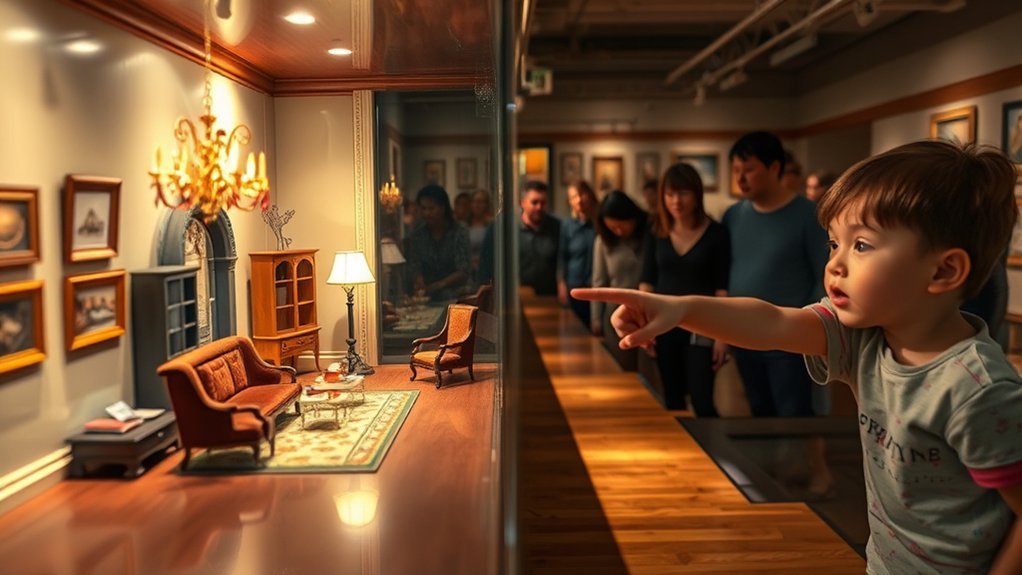
Step into a world shrunk to the size of a thumbnail at the Mini Time Machine Museum of Miniatures, where meticulously crafted rooms, dolls, and tiny scenes draw you close enough to study every painted doorknob and wallpaper pattern. You’ll wander galleries filled with period rooms, fairy-tale vignettes, and contemporary dioramas that showcase astonishing craftsmanship from around the globe. Audio guides and friendly docents point out techniques—hand-carved furniture, scaled textiles, and working lights—that make each piece feel alive. You can join a hands-on workshop to try dollhouse scale measuring and basic carpentry, or shop for unique miniatures in the museum store. Special exhibits rotate frequently, so check the calendar for themed displays and guest artist events. Photography is allowed in most areas, letting you capture tiny details for inspiration. Whether you’re a collector, a designer, or simply curious, the museum offers an intimate, immersive experience that reveals how much emotion and history can fit into a space no larger than your palm.
Hike Sabino Canyon Recreation Area
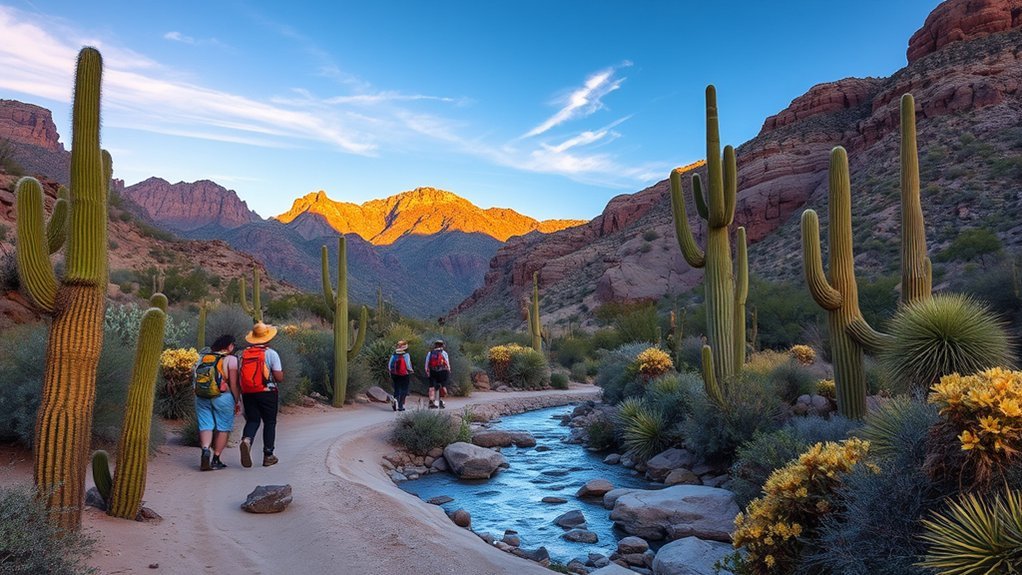
Framed by saguaros and the rugged Santa Catalina foothills, Sabino Canyon Recreation Area offers a revitalizing escape where you can hike shaded trails, cross stone bridges, and listen to seasonal waterfalls tumble into clear pools. You’ll find trails for every pace: gentle paths along the creek, steeper routes climbing to viewpoints, and rugged washes that reward steady footing and focus. Bring water, sun protection, and sturdy shoes; elevation and desert sun can surprise you. Ranger-led programs and interpretive signs explain the canyon’s geology, wildlife, and cultural history, so you’ll leave informed as well as refreshed. If you prefer, take the narrated shuttle to access upper trailheads without the steep drive.
Framed by saguaros, Sabino Canyon invites shaded hikes, seasonal waterfalls, and panoramic views—bring water, sun protection, and sturdy shoes.
- Take the Lower Sabino Creek Trail for easy creekside walking and wildlife spotting.
- Hike the Seven Falls route when water’s flowing for dramatic cascades and photo ops.
- Climb to the Bear Canyon overlook for panoramic Tucson and Catalina views.
Explore the Mercado San Agustin and Food Stalls
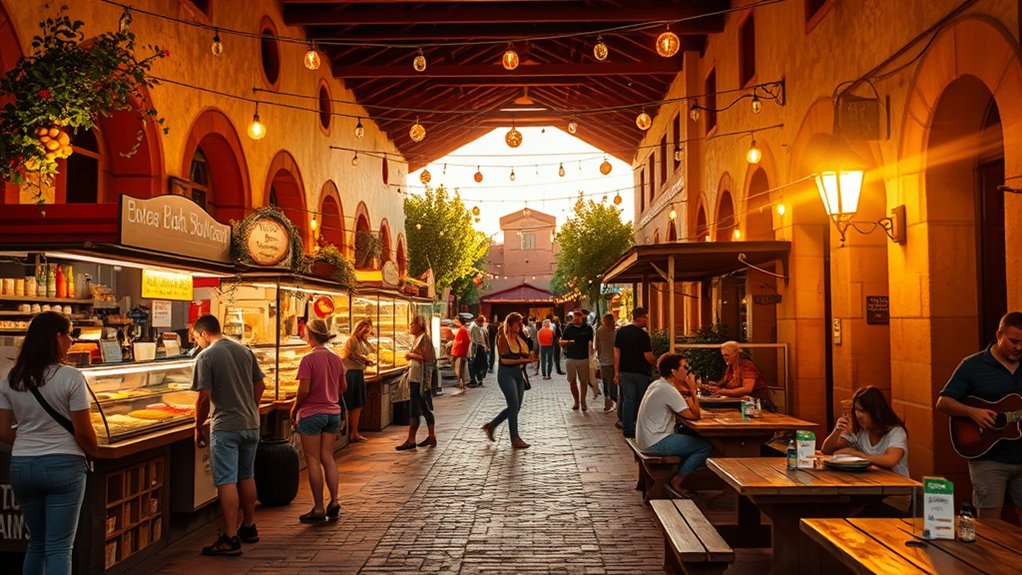
After a morning on the trails, head into central Tucson to explore Mercado San Agustín, a lively public market where local chefs, bakers, and artisans gather under a light-filled arcade. You’ll find a compact, convivial space where food stalls offer inventive takes on Sonoran classics and seasonal small plates — think hand-pressed tortillas, slow-roasted meats, fresh tortillas, and vibrant salsas. Grab a coffee from a specialty roaster, sample creative pastries, and order a shareable dish to taste multiple vendors. The indoor-outdoor layout makes it easy to linger; benches and communal tables encourage conversation with locals and travelers alike. Besides food, browse stalls selling ceramic wares, artisanal chocolate, and crafts that reflect Tucson’s creative scene. Weekly events like popup dinners and live music add energy, so check the calendar before you go. You’ll leave satisfied and inspired, with new favorite flavors and a better sense of Tucson’s culinary community.
Take a Guided Stargazing Tour in the Desert
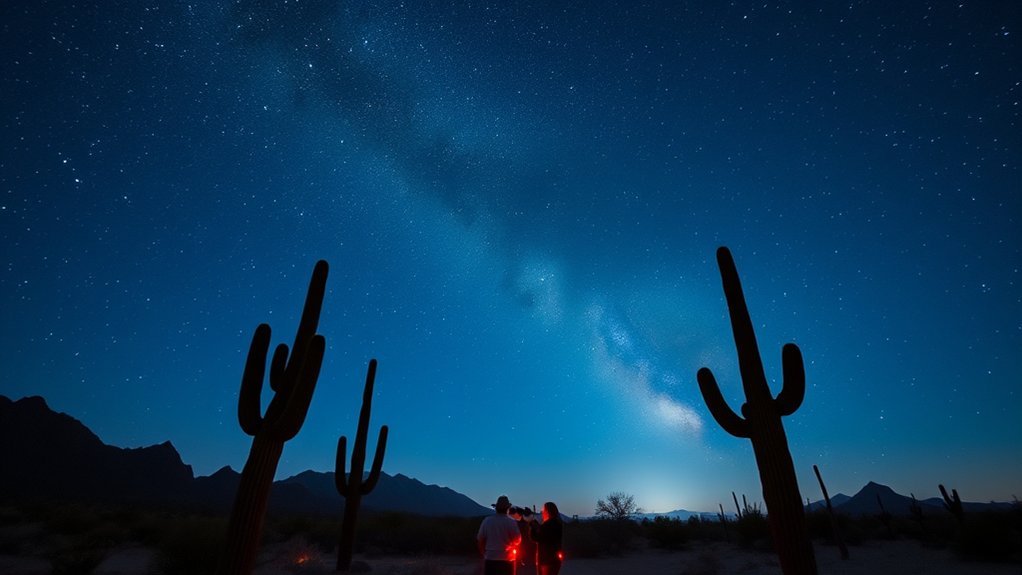
When the desert sky darkens and the heat of the day finally eases, join a guided stargazing tour to see Tucson’s famously clear, low-light skies come alive; trained guides point out constellations, explain desert astronomy, and bring high-powered telescopes so you can spot planets, star clusters, and distant galaxies in crisp detail. You’ll learn to read the sky, hear stories behind patterns, and watch seasonal sights like Saturn’s rings or the Milky Way’s band stretch overhead. Tours often choose remote spots with minimal light pollution, so colors and faint objects pop. Dress warmly for desert nights, bring a red-light flashlight, and arrive early to watch twilight shift to a canopy of pinprick stars.
Join a guided stargazing tour in Tucson—telescopes, expert guides, and pristine dark skies reveal planets, star clusters, and the Milky Way.
- Arrive early: acclimate to the dark and catch planet visibility.
- Ask questions: guides tailor explanations to your interest level.
- Use provided optics: telescopes and binoculars reveal deep-sky detail.
Tour Historic El Presidio Neighborhood
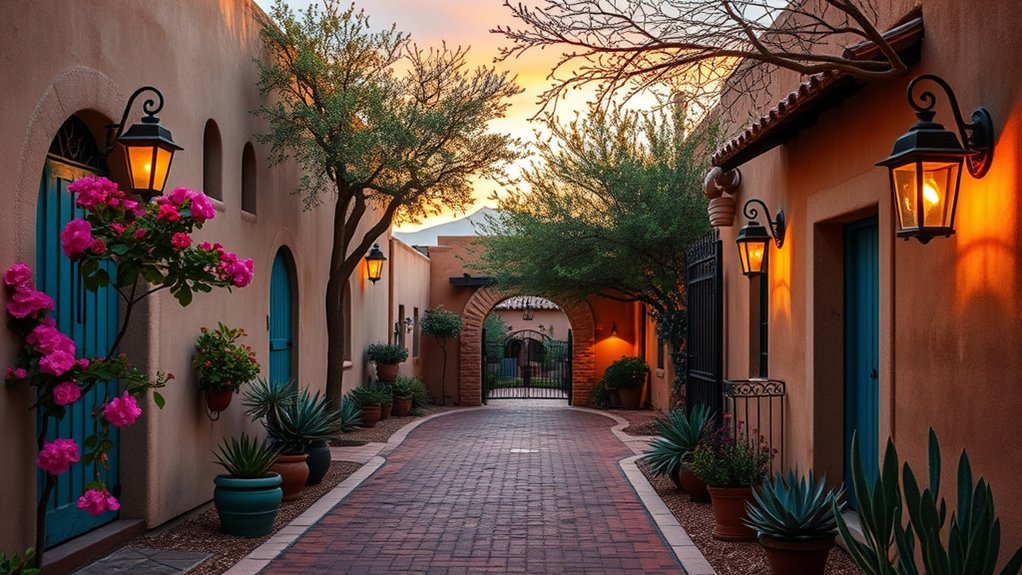
Step into El Presidio and you’ll be walking through Tucson’s 18th- and 19th-century heart, where narrow streets, adobe homes, and historic plazas map out the city’s earliest Spanish and Mexican roots. You can wander by low-slung houses with thick walls and wooden vigas, imagining daily life centuries ago, while plaques and restored façades point out key sites like the Presidio San Agustín del Tucson footprint. Take a guided walking tour to hear stories about settlers, artisans, and conflicts that shaped the barrio, or use a self-guided map to move at your own pace. Stop at small galleries, mission-era churches, and hidden courtyards to observe craftsmanship and colorful tilework. Photography lovers will find compelling textures and light, especially in the soft morning sun. Look for local events and walking lectures that often focus on architecture and preservation. You’ll leave with a clearer sense of Tucson’s layered past and a fresh appreciation for its enduring cultural landscape.
Visit the DeGrazia Gallery in the Sun
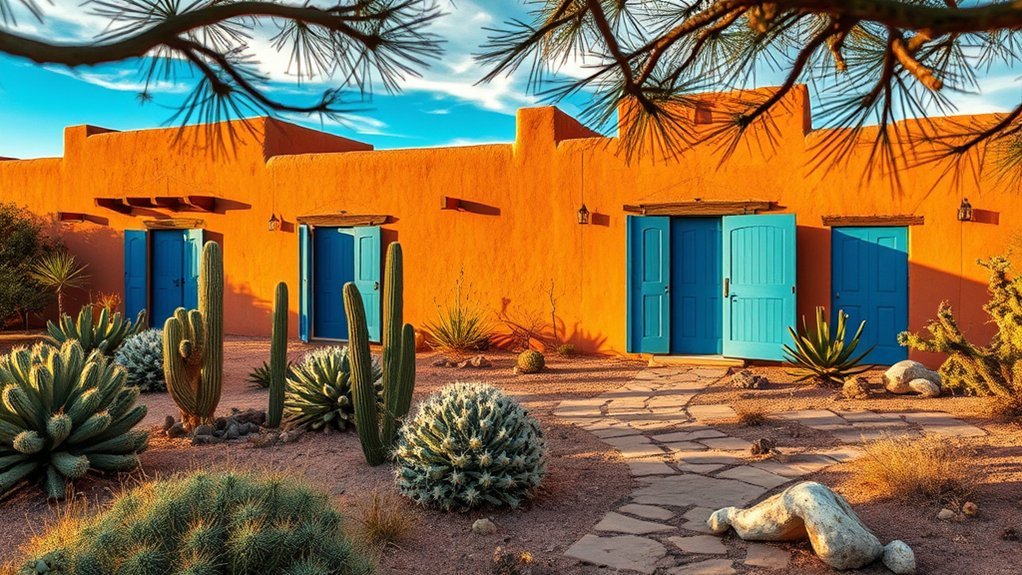
Although tucked into the foothills it feels like a world apart, the DeGrazia Gallery in the Sun invites you into a vividly personal vision of the Southwest—an adobe compound created by artist Ted DeGrazia that blends galleries, chapels, gardens, and murals into a single immersive experience. You’ll wander sun-warmed courtyards, study intimate plein-air paintings, and feel how architecture and art echo desert light. The little chapel, decorated with DeGrazia’s signature childlike figures, offers a quiet pause; the galleries display original canvases and prints that capture native culture, landscapes, and everyday moments.
- Tour the main gallery to see vibrant oil and watercolor works that illustrate DeGrazia’s storytelling and palette.
- Stroll the Mediterranean-style gardens and walkways to appreciate site-specific sculptures and murals framed by saguaros.
- Visit the chapel and gift shop to pick up prints, learn about DeGrazia’s life, and support conservation of the compound.
Plan a relaxed visit—you’ll leave with a stronger sense of Tucson’s artistic heart.
Explore Colossal Cave Mountain Park
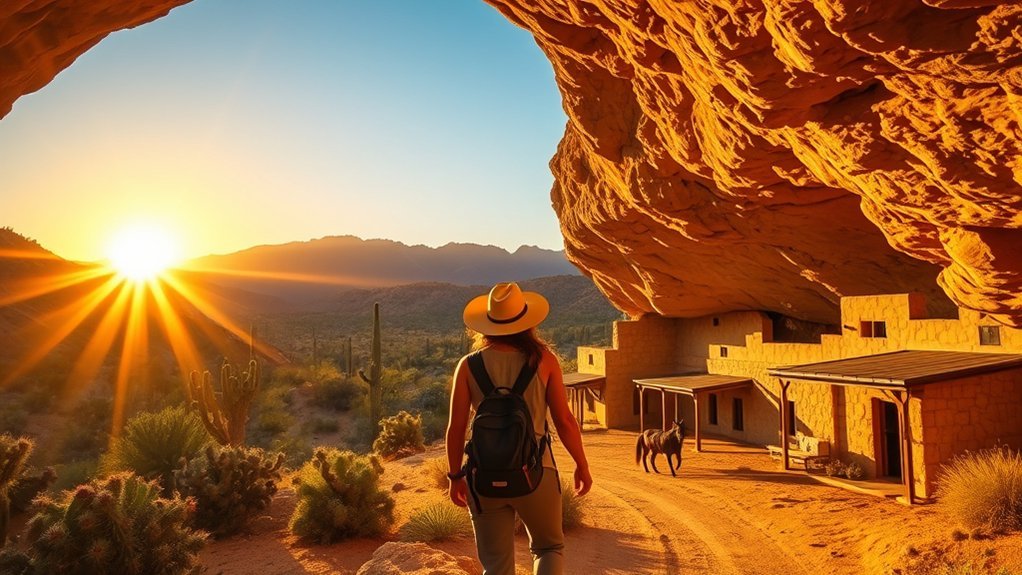
After soaking in DeGrazia’s sunlit courtyards, head southeast to Colossal Cave Mountain Park, where a different kind of wonder waits beneath the surface. You’ll start at the visitor center, grab a map, and join a guided cavern tour that reveals stalactites, stalagmites, and delicate flowstone carved over millennia. Guides explain geology and local history—how early explorers, miners, and Indigenous peoples used the cave—so you get context, not just sights. Above ground, hike easy to moderate trails through desert scrub and saguaro-studded canyons, watching for birds and lizards. Bring water, sturdy shoes, and a light jacket; the cave stays cool year-round. Picnic areas and interpretive signs make for a relaxed visit, and seasonal events like evening lantern tours add atmosphere. Whether you’re curious about speleothems, regional natural history, or a peaceful outdoor escape, Colossal Cave Mountain Park delivers a memorable, well-rounded experience close to Tucson.
Attend a Spring Wildflower Excursion
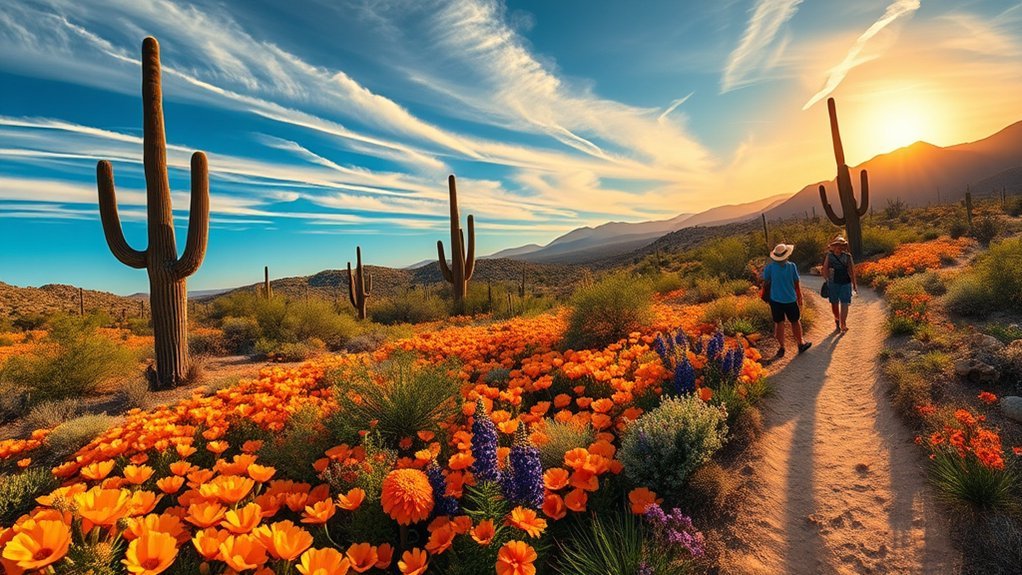
When spring rains coax the desert awake, join a guided wildflower excursion to see washes and hillsides burst with color—you’ll learn to identify poppies, lupine, brittlebush, and more while guides explain how elevation, recent rainfall, and soil type shape each bloom display. You’ll walk gentle trails where carpets of color appear after the right winter storms, and guides point out subtle distinctions between species and pollinator relationships. Bring sturdy shoes, a hat, water, and a camera; excursions usually last a few hours and move at a comfortable pace so you’ll get close views without trampling fragile plants. Expect short interpretive stops to learn about seed dormancy and desert survival strategies.
- Learn: guides teach ID tips, bloom timing, and ecological context.
- Photograph: find ideal light in washes and on slopes without disturbing plants.
- Timing: check recent rainfall reports—peak displays depend on seasonal storms and temperature.
Shop and Dine in Downtown Tucson
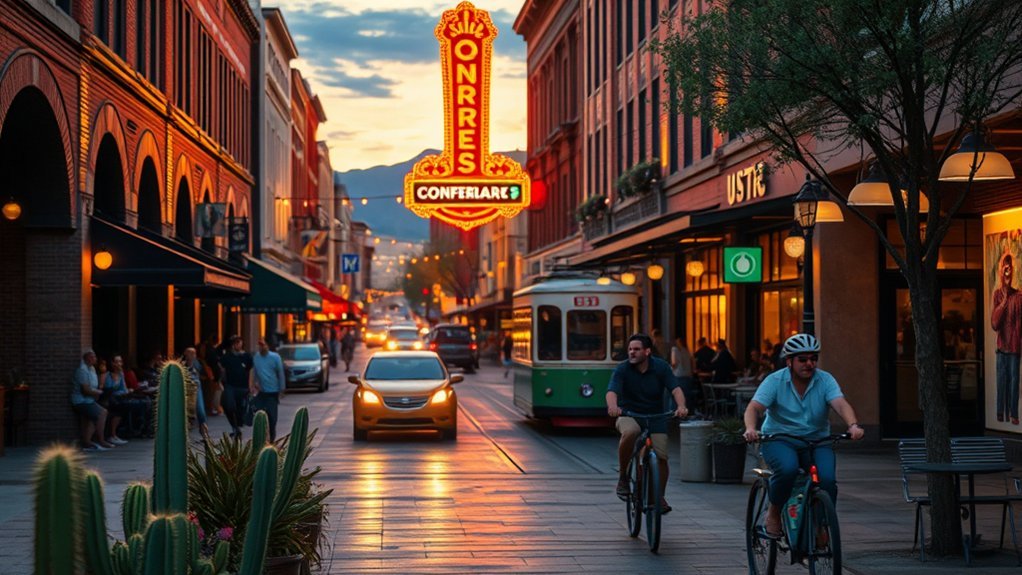
From the quiet trails of the foothills you can head back into the city and find a lively downtown where historic storefronts, hands-on galleries, and Mexican-American food traditions sit within easy walking distance. Wander Sixth Street and Congress for an eclectic mix of boutiques selling desert-inspired jewelry, hand-thrown pottery, and locally printed tees. Pop into independent galleries to meet artists or book a quick glassblowing demo—you’ll see craft and conversation blend seamlessly. For bites, choose from longstanding Sonoran kitchens dishing carne asada, tamales, and fresh tortillas to inventive eateries plating seasonal, Sonoran-influenced fare. Sip a mezcal flight at a cozy bar, or grab a specialty coffee and watch the neighborhood pulse. Weekly markets and pop-ups spotlight local growers and makers, so check schedules before you go. Walkable blocks, shaded patios, and public art make exploring easy and rewarding; you’ll leave with unique finds and a better sense of the city’s creative heart.
Take a Desert Photography Tour
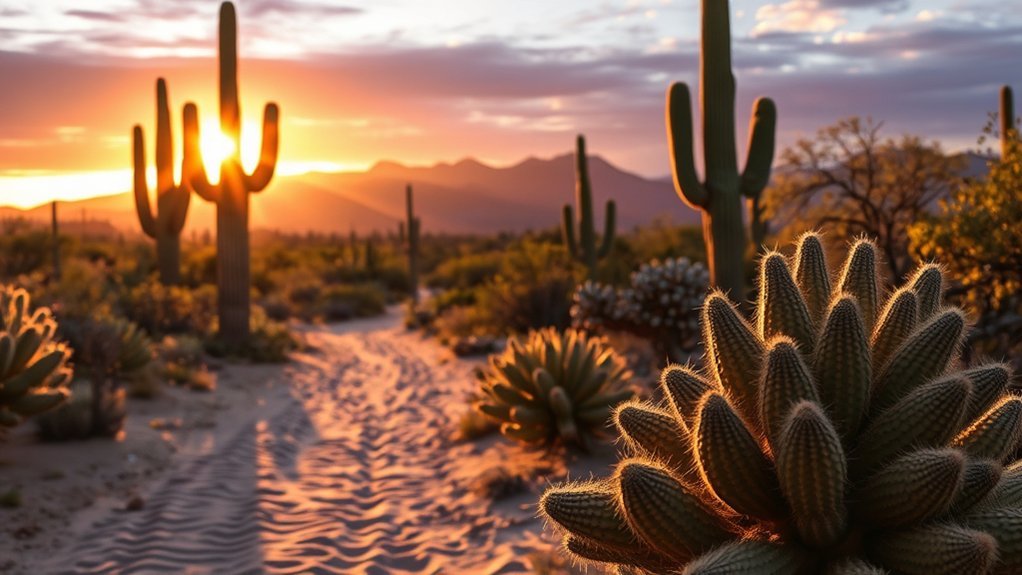
Head out at golden hour and you’ll see why Tucson’s desert is a photographer’s dream: sweeping saguaros silhouette against pastel skies, brittle bush and ocotillo adding texture, and distant mountain ridgelines layering depth into every frame. Join a guided desert photography tour and you’ll get expert tips on composition, exposure, and reading light so your shots capture the landscape’s subtle drama. Tours scout vantage points you might miss, time stops for magic-hour color, and leaders often bring neutral-density filters, tripods, and local knowledge about where wildlife appears.
- Learn techniques: framing, depth of field, and using foreground elements to create scale.
- Scout locations: iconic saguaros, washes with reflective pools after rains, and secluded canyon viewpoints.
- Gear & safety: recommendations for lenses, tripod setups, sun protection, and desert etiquette to protect plants and animals.
You’ll leave with stronger images, fresh perspectives, and confidence to explore Tucson’s light on your own.
Frequently Asked Questions
When Is the Best Time of Year to Visit Tucson?
You’ll find the best time is fall through spring — October to May — when temperatures’re mild, skies are clear, and hiking, museums, and desert blooms’re delightful; summers’re hot, so avoid June–September unless you love intense heat.
What Vaccinations or Health Precautions Are Recommended for Desert Travel?
Picture sunbaked trails and cacti silhouettes: you should get routine vaccines, update tetanus, consider hepatitis A, flu, and COVID shots, pack insect repellent, drink purified water, and carry a basic first-aid kit for heat and bites.
How Safe Is Tucson for Solo Travelers at Night?
Tucson’s generally safe, but you’ll want to stay alert at night; stick to well-lit areas, avoid isolated spots, use rideshares, trust your instincts, keep valuables hidden, and check local news or neighborhood apps for real-time safety updates.
Are There Public Transportation Options to Reach Attractions?
Yes — over 80 bus routes and Sun Tran shuttles connect downtown and key sites, so you can reach museums, parks, and the historic district; rideshares and Sun Link streetcar fill gaps for flexible, convenient sightseeing.
Where Can I Find Accessible (ADA) Services at Major Sites?
You’ll find ADA services at major sites via visitor centers, ticket desks, and official websites; they’ll list accessible parking, ramps, restrooms, and shuttle options, and staff can arrange accommodations or provide mobility aids upon request.
Conclusion
You’ve just scratched the surface of Tucson’s desert theater — from towering saguaros to adobe whispers at Mission San Xavier, each trail and market is a stanza in a Sonoran poem. Wander like a curious traveler in a Western film, pause for wildflower confetti, and let sunset paint Gates Pass like an old master. Pack your camera, your curiosity, and an appetite for slow, sunlit discovery — the desert’s stories are waiting for you.

